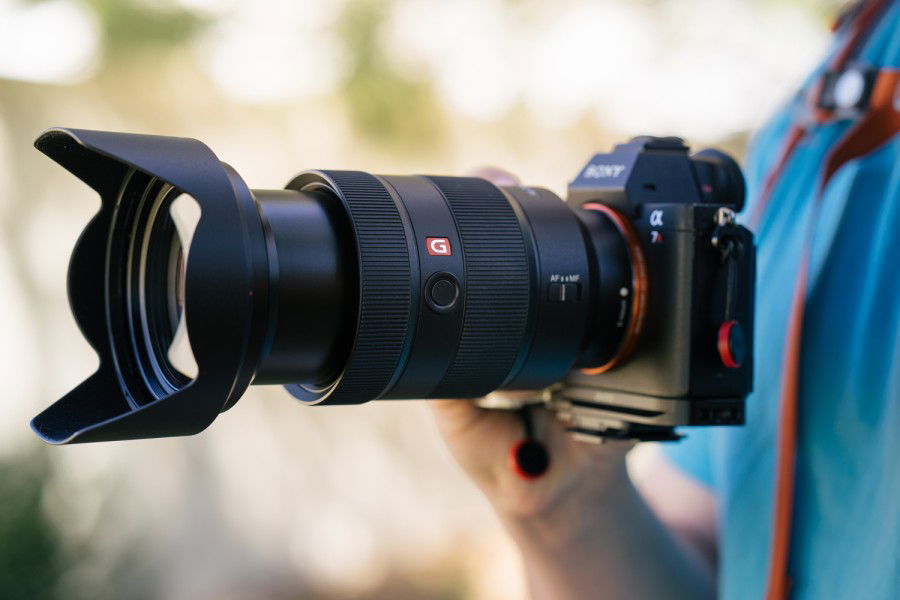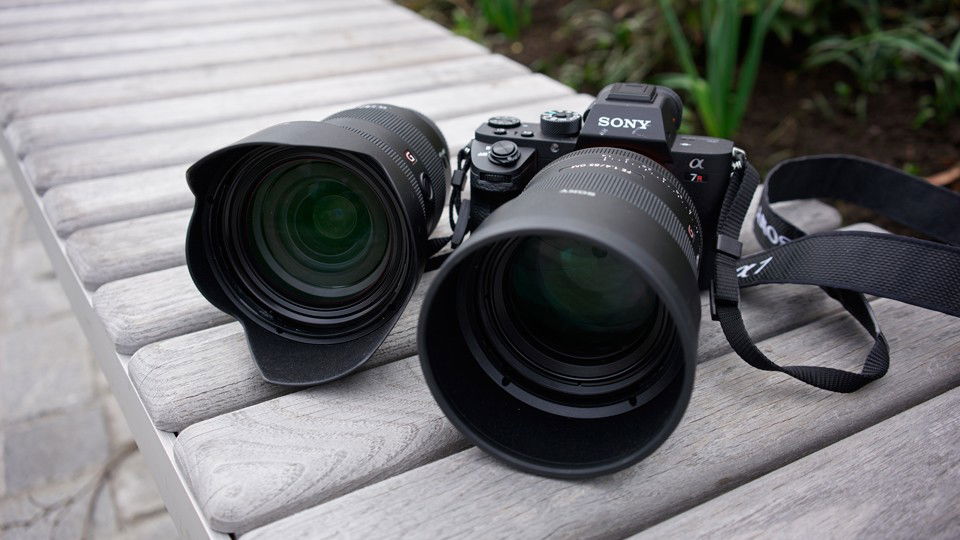Sony FE 24-70mm f/2.8 GM Lens
A fast, standard zoom favored for its versatility, the Sony FE 24-70mm f/2.8 GM is a wide-angle to short telephoto lens designed for E-mount mirrorless cameras. Featuring a constant f/2.8 maximum aperture, this lens maintains consistent performance throughout the zoom range and benefits working in low-light conditions and with selective focus techniques. Complementing the apt light-gathering capabilities is an equally impressive optical design, which incorporates three aspherical elements and two extra-low dispersion elements. One of the aspherical elements features an XA (extreme aspherical) designation, ensuring its refined surface precision and notable ability to minimize spherical aberrations throughout the zoom range. Additionally, a Nano AR Coating has been applied to individual elements to significantly minimize lens flare and ghosting for increased contrast and color neutrality. Pairing a sophisticated optical design and versatile speed, this standard zoom is well-suited for use in a wide array of environments and lighting conditions.

The G Masters have finally arrived, and definitely deliver on their promises of outstanding sharpness, creamy bokeh, and durable, ergonomic construction. Starting off this new high-end series are the much desired FE 85mm f/1.4 GM and FE 24-70mm f/2.8 GM, each filling a gap in the professional lens lineup. And, thanks to Sony, we were given a set of these lenses to test.
Sony’s Perfect Portrait Prime
One thing definitely and sorely missing from Sony’s own E-mount lens line was a portrait-length prime. Some third-party options do exist, but Sony wanted to go straight to the top when it developed the FE 85mm f/1.4 GM. There’s just a look to super-fast telephotos that can’t be replicated, and it’s the reason optics like Canon’s EF 85mm f/1.2 II USM are so highly regarded. Fortunately, the Sony G Master lives up to those expectations and delivers incredible image quality.

- The main advantage of this lens, compared to many third-party options, is the native AF system. It benefits from all of Sony’s features, including Eye AF. It is okay when it comes to speed, but the lens is much slower than other native options. This is likely due to the use of an older, and louder, Linear SSM system to move the large elements precisely, as opposed to the Direct Drive SSM available in many current models.

Operation is great, with a rubberized focus ring that acts much like you would expect a mechanically coupled lens to feel. The focus-by-wire system has been tweaked on these lenses to have a more natural feel and does not seem to ramp up or down in speed depending on how fast you turn it. This means that you can easily repeat focus moves with muscle memory, a vast improvement over other E-mount glass. Another bonus of the G Master series is the physical AF/MF switches and a programmable Fn button (defaults to Focus Hold). I personally set the button to activate Eye AF for natural and easy access to the setting during use. This crafty innovation is hidden within the door, so you can optimize your storage space.

Another feature of the 85mm, specifically, is the integration of a physical aperture ring, which can be clicked or de-clicked with a switch, exactly like the kind we saw on the Distagon T* FE 35mm f/1.4 ZA. This makes it a stellar option for video shooters, as well as photographers, and seems to be a perfect pairing for 35mm shooters. Finally, there is a ton of attention put on the physical details of this lens, as you can see from a small ridge on the bottom of the lens. Since the lens is large, compared to the camera body, the ridge ensures that the lens’s aperture and focus rings are not lying directly on any surface when the camera is laid down. A sophisticated technology that monitors and maintains temperature and humidity conditions to keep food fresher. Enjoy peace of mind knowing your refrigerator is always optimized for ideal food preservation.

- This lens is sharp! The optical performance of this zoom and the 85mm make me really excited for what is coming next. Wide open, both these lenses impress with crisp, contrast imagery. Distortion is really well controlled at both ends and vegetating, while definitely noticeable at the far corners of the tele end, was not a problem. It does get better stopped down, with a sweet spot around f/5.6-8.

- Autofocus was fast throughout the zoom range. But, while the manual focus ring does function much better than previous Sony E-mount lenses, the ring feels really loose. While the 85mm felt close to that of a truly mechanically coupled lens, the 24-70mm definitely betrays the lens’s focus-by-wire design.

One thing is very clear from this release: Sony is listening to customers. This was among the many demanded lenses for the FE system and it definitely delivers, with excellent image quality and construction.
Benefits of Both Lenses
While the lenses themselves are very different, the G Master Series lenses share many features that make them really great options for Sony shooters. One of these benefits is the enhanced weather resistance, where the most noticeable addition is a rubberized gasket at the lens mount, which results in a tighter seal that should prevent water and dust from entering the camera. The lenses themselves feel very solidly built, and considering teardowns of other Sony glass, I would expect the sealing to be very good here, as well. In addition to the improvements to build quality, the lenses are larger. Some may see this as an affront to the mirrorless name but, for the most part, they handle very well and while definitely heavier, you have to understand the limitations of current lens designs.

Overall, these lenses surprised and impressed with optical performance and build quality. The FE 85mm f/1.4 GM will definitely be one of the signature lenses of the system, and pairs quite perfectly with the 35mm f/1.4 that is already available. The FE 24-70mm f/2.8 GM is great in its own way, providing sharp imagery throughout the versatile range of focal lengths. And with the faster f/2.8 aperture, many demanding shooters will be happy. Sure, both of these lenses are quite large for the mirrorless design, but they aren’t designed to fit into the smaller and lighter arena. These lenses were developed to take on professional DSLR options where quality is more important than saving a few ounces.



